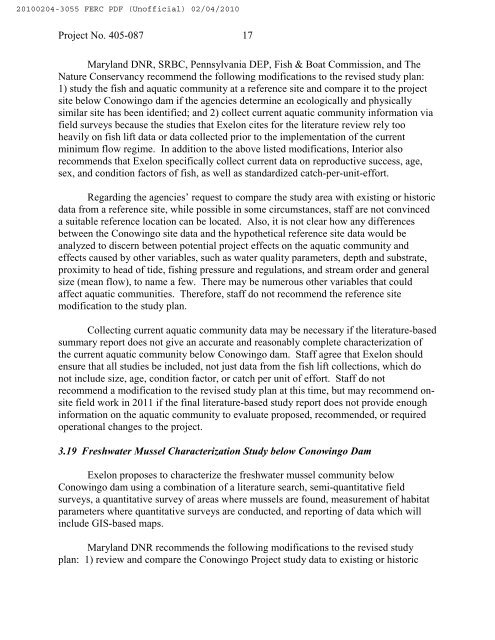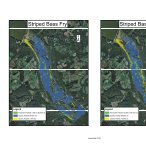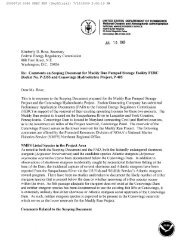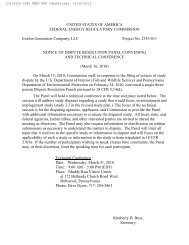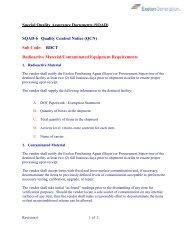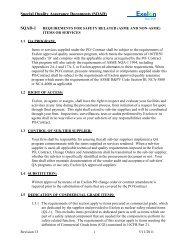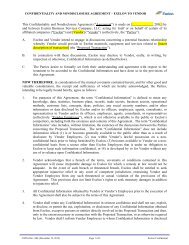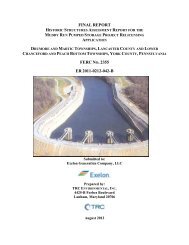FEDERAL ENERGY REGULATORY COMMISSION Project No. 405 ...
FEDERAL ENERGY REGULATORY COMMISSION Project No. 405 ...
FEDERAL ENERGY REGULATORY COMMISSION Project No. 405 ...
Create successful ePaper yourself
Turn your PDF publications into a flip-book with our unique Google optimized e-Paper software.
20100204-3055 FERC PDF (Unofficial) 02/04/2010<br />
<strong>Project</strong> <strong>No</strong>. <strong>405</strong>-087 17<br />
Maryland DNR, SRBC, Pennsylvania DEP, Fish & Boat Commission, and The<br />
Nature Conservancy recommend the following modifications to the revised study plan:<br />
1) study the fish and aquatic community at a reference site and compare it to the project<br />
site below Conowingo dam if the agencies determine an ecologically and physically<br />
similar site has been identified; and 2) collect current aquatic community information via<br />
field surveys because the studies that Exelon cites for the literature review rely too<br />
heavily on fish lift data or data collected prior to the implementation of the current<br />
minimum flow regime. In addition to the above listed modifications, Interior also<br />
recommends that Exelon specifically collect current data on reproductive success, age,<br />
sex, and condition factors of fish, as well as standardized catch-per-unit-effort.<br />
Regarding the agencies’ request to compare the study area with existing or historic<br />
data from a reference site, while possible in some circumstances, staff are not convinced<br />
a suitable reference location can be located. Also, it is not clear how any differences<br />
between the Conowingo site data and the hypothetical reference site data would be<br />
analyzed to discern between potential project effects on the aquatic community and<br />
effects caused by other variables, such as water quality parameters, depth and substrate,<br />
proximity to head of tide, fishing pressure and regulations, and stream order and general<br />
size (mean flow), to name a few. There may be numerous other variables that could<br />
affect aquatic communities. Therefore, staff do not recommend the reference site<br />
modification to the study plan.<br />
Collecting current aquatic community data may be necessary if the literature-based<br />
summary report does not give an accurate and reasonably complete characterization of<br />
the current aquatic community below Conowingo dam. Staff agree that Exelon should<br />
ensure that all studies be included, not just data from the fish lift collections, which do<br />
not include size, age, condition factor, or catch per unit of effort. Staff do not<br />
recommend a modification to the revised study plan at this time, but may recommend onsite<br />
field work in 2011 if the final literature-based study report does not provide enough<br />
information on the aquatic community to evaluate proposed, recommended, or required<br />
operational changes to the project.<br />
3.19 Freshwater Mussel Characterization Study below Conowingo Dam<br />
Exelon proposes to characterize the freshwater mussel community below<br />
Conowingo dam using a combination of a literature search, semi-quantitative field<br />
surveys, a quantitative survey of areas where mussels are found, measurement of habitat<br />
parameters where quantitative surveys are conducted, and reporting of data which will<br />
include GIS-based maps.<br />
Maryland DNR recommends the following modifications to the revised study<br />
plan: 1) review and compare the Conowingo <strong>Project</strong> study data to existing or historic


